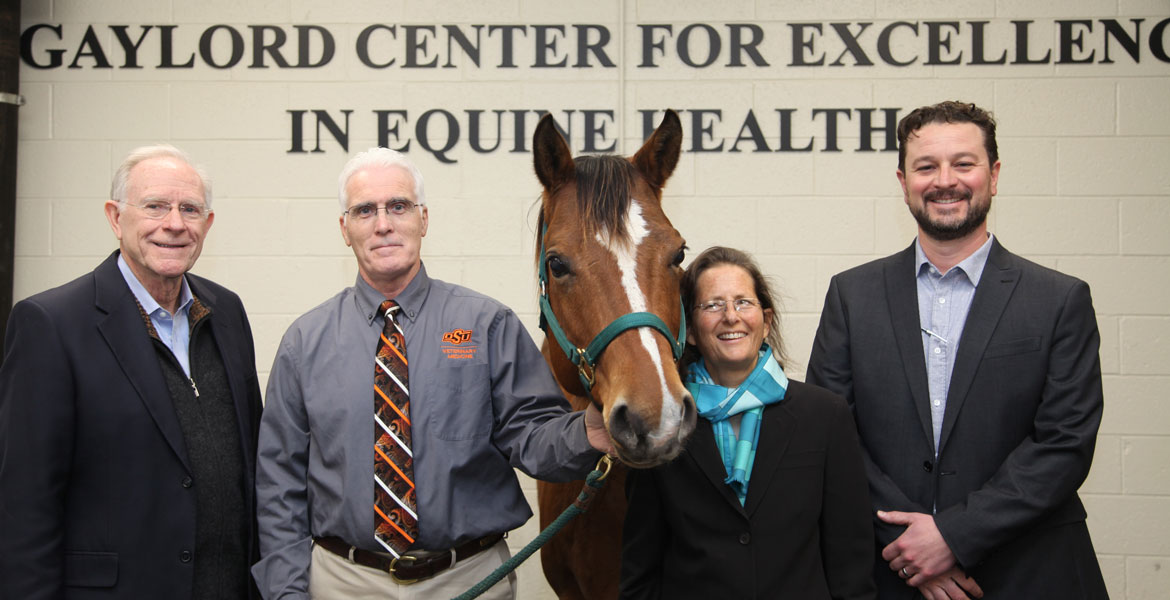
Research to Aid Wild Horses
Tuesday, February 18, 2020
The Bureau of Land Management (BLM) manages and protects wild horses and burros on public lands across 10 western states. The BLM and the U.S. Geological Services (USGS) have been working with Dr. Reed Holyoak at Oklahoma State University College of Veterinary Medicine on contraception methods for mares to help curb herd overpopulation.
“We started to test different sizes and different tensile strength O rings in a group of mares,” said Holyoak, DVM, Ph.D., DACT, Bullock Professor of Equine Theriogenology at the college’s ranch. “However, we found out that the mares did not like the O rings and would expel them during their normal cycle. I met with OSU’s Dr. Shuodao Wang, assistant professor of mechanical and aerospace engineering. We came up with a Y design IUD very similar to the T design used in humans. The BLM and USGS agreed for us to do a pilot study using two different tensile strengths of the Y design.”
The goal of the study was to have a non-detrimental IUD.
“Some human IUDs cause damage and potential infertility,” said Holyoak. “We wanted contraception but not to damage the mare’s uterus so that after five years, you can remove the IUD and still save the genetic potential of this group of mustangs. Something that was non-scarring, kept them from getting pregnant, and didn’t destroy their fertility.”
Holyoak reported that the O rings didn’t hurt the mare and neither did the Y design IUD. The group decided to move forward to determine the retention rate through two breeding seasons. Since the O rings were being expelled, they used the Y IUD with two breeding pods at the college’s ranch – a stallion and 10 mares in each pod, in a free-range pasture environment very similar to a feral horse population.
“The desire was to have a greater than 70 percent retention. If you can reduce the foal crop in these feral horses by 70 to 75 percent, then over a few years, you can get ahead of or at least catch up with the overpopulation problem which is huge.”
The study resulted in a 75 percent retention rate. None of the mares that retained the IUD got pregnant.
“At the end of the study, we removed the IUDs, took our samples to demonstrate whether we had scar tissue develop or not, and then turned them back out in their breeding pods. Many of them got pregnant just as we expected. So we hit the marks as far as the reason for the study.”
OSU graduate and adjunct professor, Billy Clay, DVM, DABVT, of Stillwater, is also interested in the overpopulation of feral horses, donkeys and other equidae. SpayFirst, an Oklahoma based nonprofit animal welfare organization, recently received regulatory approval to manufacture and sell GonaCon EQ®.
“Through a cooperative effort with the U.S. Department of Agriculture Wildlife Services, we developed GonaCon EQ® to control estrous in feral horses, donkeys and other equidae,” said Clay, vice president and development coordinator of SpayFirst.
Clay works with Ruth Steinberger, chief executive officer based in Bristow, Oklahoma, and Jeffery Kemp, PhD, chief scientific officer and manufacturing director based in Fort Collins, Colorado. The focus of the company is to control feral and wild animals where their increasing populations pose an animal welfare threat. Research is underway with similar products for dogs, cats, swine, badgers and others.
“A majority of the feral horse population is not mustangs,” said Holyoak. “Some of these horses have halters on them. They are abandoned and now their offspring are feral too. We need to maintain and control the population so they are not over grazing, not destroying the habitat. The IUD, if administered to the original mustang pools, will maintain their genetic line while a product like GonaCon EQ® can be used to shut down the reproductive cycle of abandoned feral horses. We have plenty of horses in the United States. We don’t need to be producing somebody else’s discard. We need to focus on managing the feral horse population while preserving the mustangs’ genetic potential.”
If you would like to support research at Oklahoma State University College of Veterinary Medicine, please contact Ashley Hesser, assistant director of development at the OSU Foundation, at ahesser@osugiving.com or 405-385-0715. For more information on SpayFirst, visit http://www.spayfirst.org/.
MEDIA CONTACT: Derinda Blakeney, APR | OSU College of Veterinary Medicine | 405-744-6740 | derinda@okstate.edu
